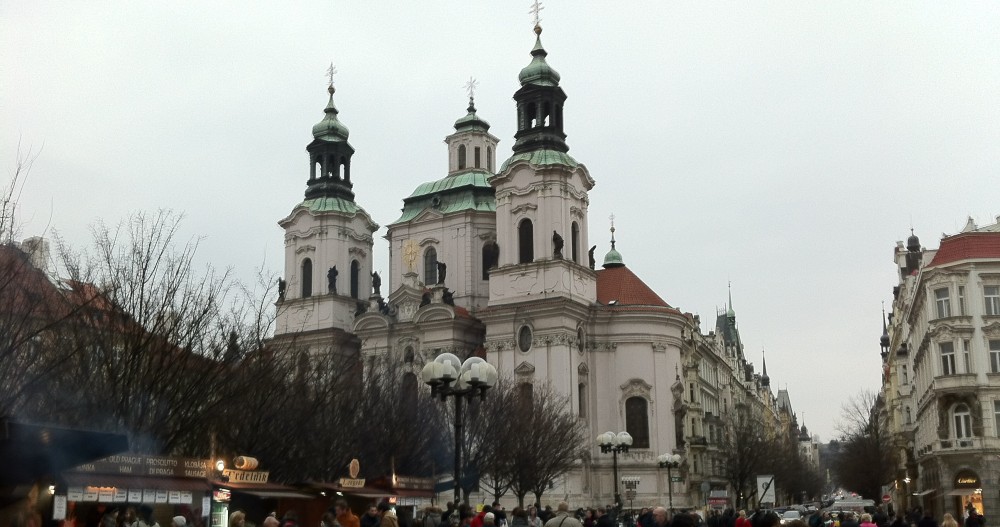
The Jan Hus Memorial on the Old Town Square of Prague is built atop the place where the witch Fen’ka is lynched by the mob in the opening pages of “Come Hell or High Water.”
The Come Hell or High Water trilogy is gripping historic-fantasy that erupts in 1356 as a witch’s curse rings out over Prague’s Old Town Square. As the old crone is bound to a stake and consumed by flames, her vengeful words set in motion a series of dark events that unfold across the centuries, culminating in the historic flood of 2002 that threatens to destroy the city.
Readers of David Devereux and Jim Butcher will respond to the authentic magical practices and the detective work in both aspects of the story as Nadezhda and the academics each sleuth for the source of the evil they see working itself out in the life of the city and their search for the magical practice(s) that will be able to avert the coming disaster. Readers of Mike Carrey’s Felix Castor books will appreciate the interaction of the living and the dead throughout the story while readers of Kate Griffen’s Matthew Swift series will enjoy the intimate association of the magic with specific moments and monuments of Prague’s history and culture. Fans of Robert Langdon’s adventures will appreciate the authentic history that is woven into the story.
“A historically rich page-turner set in medieval Eastern Europe…. Dark deeds of the past echo down through the years creating a monstrous memory that only an intrepid band of scholars can dispel…. The author, a veritable DAN BROWN OF PRAGUE, weaves his tale through time showing how the nefarious events of the past never die and live on in the present as dark memories that hide in every nook and cranny of the picturesque capital of the modern day Czech Republic.” — Journal of Monsters and the Monstrous
From Publishers Weekly:
“Morris generates genuine chills and thrills in this entertaining series that alternates between the 14th and 21st centuries…. The author’s background in medieval history stands him in good stead in the 14th-century sections, as he slips in interesting details to help make the fantastic plausible.”
From Kirkus Indie Reviews:
“A group of professors specializing in folklore attempts to prevent George, a powerful priest, and Elizabeth, an Irish vampire, from unleashing an evil that threatens to destroy all of Prague…. Both sides scramble to find four magical items that protect Prague from evil: a sword, a staff, a pentacle and a chalice. The first half of the novel is a mystery in which the professors try to identify the magical items, while the second half becomes a suspenseful race as both sides try to obtain the items.”
“… they include evocative scenes featuring Czech slang and medieval social and religious practices, with characters, particularly women, using the occult to rebel against the rigid social bonds of the time, marriage especially. … the sense of danger in this outing is palpable from the start, and the intensity lets up. Also included are several Czech legends, such as the story of Rabbi Judah ben Loew creating the Golem, which should appeal to readers with an interest in folklore.
A stark division of narratives, but each is absorbing.”
“Well-versed in 14th-century Prague, Morris draws heavily on folk legends to create a window into the lives of characters from various walks of life, including righteous priests, wealthy merchants and budding thieves.”
“Naïve, young Magdalena … tangles with a witch’s ghost who pulls her into an underworld of sorcery and vampires. That encounter propels her and various helpers and enemies through the first two novels in the series, leading up to this installment, which ties up the trilogy with pyrotechnics and a twist reminiscent of Mario Bava’s film Black Sunday.”
From Blue Ink Reviews:
“The exploration of various European myths and legends is the fuel that powers the storyline, and the understated use of supernatural characters (ghosts, trolls, etc.) throughout gives the novel a darkly magical but realistic tone.
“This is a highly intelligent … saga that will appeal to fans of folkloric fantasy and historical fiction.”
This supernatural suspense… is the beginning of a trilogy that has the potential to be a genre-transcendent epic a la Deborah Harkness’ bestselling All Souls trilogy (A Discovery of Witches, et al.)”
From Perspectives on Tarot:
“This is a book that you just do not want to put down! It is all about the past, and how the energy from the past lives on in the present…. This is a well-researched book, from the point of view of medieval history, the Tarot itself, occult practices, the church, and the psyche behind what motivates people to act as they do.”
